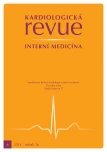Oral antidiabetic drugs – fixed combination therapy
Authors:
M. Kvapil
Authors‘ workplace:
Interní klinika 2. LF UK a FN v Motole, Praha
Published in:
Kardiol Rev Int Med 2014, 16(6): 454-457
Category:
Cardiology Review
Overview
Type 2 diabetes mellitus is caused by the presence of disturbances in insulin secretion, insulin resistance and reduced action of the incretin axis. At present, any disorder can be influenced pharmacologically. Therefore, combination therapy is a rational basic principle for pharmacological intervention in type 2 diabetes. It facilitates an individual approach to therapy.
Keywords:
type 2 diabetes mellitus – oral antidiabetic drugs – fixed combination therapy
Sources
1. Santos ‑ Oliveira R, Purdy C, da Silva MP et al. Haemoglobin A1c levels and subsequent cardiovascular disease in persons without diabetes: a meta‑analysis of prospective cohorts. Diabetologia 2011; 54 : 1327 – 1334. doi: 10.1007/ s00125 ‑ 011 ‑ 2078 ‑ 8.
2. Ford ES, Zhao G, Li C. Pre‑diabetes and the risk for cardiovascular disease: a systematic review of the evidence. J Am Coll Cardiol 2010; 55 : 1310 – 1317. doi: 10.1016/ j.jacc.2009.10.060.
3. Huxley R, Barzi F, Woodward M. Excess risk of fatal coronary heart dinase associated with diabetes in men and women: meta‑analysis of 37 prospective kohort studies. BMJ 2006; 332 : 73 – 78.
4. Kvapil M, Perušičová J. Postprandiální glykémie. Praha: Triton 2006.
5. Ahrén B. Gut peptides and Type 2 diabetes mellitus treatment. Curr Diab Rep 2003; 3 : 365 – 372.
6. Nauck MA, Stockamenn F, Ebert R et al. Reduced incretin effect in Type 2 (non‑insulin‑dependent) diabetes. Diabetologia 1986; 29 : 46 – 52.
7. Anagnostis P, Athyros VG, Adamidou F et al. Glucagon‑like peptide ‑ 1‑based therapies and cardiovascular disease: looking beyond glycaemic control. Diabetes Obes Metab 2011; 13 : 302 – 312. doi: 10.1111/ j.1463 ‑ 1326.2010.01345.x.
8. Boussageon R, Bejan ‑ Angoulvant T, Saadatian ‑ Elahi M et al. Effect of intensive glucose lowering treatment on all cause mortality, cardiovascular death, and microvascular events in type 2 diabetes: meta‑analysis of randomised controlled trials. BMJ 2011; 343: d4169. doi: 10.1136/ bmj.d4169.
9. Mazzone T. Intensive glucose lowering and cardiovascular disease prevention in diabetes: reconciling the recent clinical trial data. Circulation 2010; 122 : 2201 – 2211. doi: 10.1161/ CIRCULATIONAHA.109.913350.
10. Zhang CY, Sun AJ, Zhang SN et al. Effects of intensive glucose control on incidence of cardiovascular events in patients with type 2 diabetes: a meta‑analysis. Ann Med 2010; 42 : 305 – 315. doi: 10.3109/ 07853891003796752.
11. Tkác I. Effect of intensive glycemic control on cardiovascular outcomes and all‑cause mortality in type 2diabetes: overview and metaanalysis of five trials. Diabetes Res Clin Pract 2009; 86 (Suppl 1): S57 – S62. doi: 10.1016/ S0168 ‑ 8227(09)70011 ‑ 7.
12. The effect of intensive treatment of diabetes on the development and progression of long‑term complications in insulin‑dependent diabetes mellitus. The Diabetes Control and Complications Trial Research Group. N Engl J Med 1993; 329 : 977 – 986.
13. Donnan PT, MacDonald TM, Morris AD. Adherence to prescribed oral hypoglycaemic medication in a population of patients with Type 2 diabetes: a retrospective cohort study. Diabet Med 2002; 19 : 279 – 284.
14. Cramer JA. A systematic review of adherence with medications for diabetes. Diabetes Care 2004; 27 : 1218 – 1224.
15. Bangalore S, Kamalakkannan G, Parkar S et al. Fixed‑dose combinations improve medication compliance: a meta‑analysis. Am J Med 2007; 120 : 713 – 719.
16. Blonde L, San Juan ZT. Fixed‑dose combinations for treatment of type 2 diabetes mellitus. Adv Ther 2012; 29 : 1 – 13. doi: 10.1007/ s12325 ‑ 011 ‑ 0094 ‑ 1.
17. Meshram DM, Langade DG, Kinagi SB et al. Evaluation of efficacy and safety of fixed dose combination of glimepiride 2 mg pluspioglitazone 15 mg plus metformin SR 500 mg in the management of patiens with type ‑ 2 diabetes mellitus. J Indian Med Assoc 2005; 103 : 447 – 450.
18. Goldstein BJ, Feinglos MN, Lunceford JK et al. Sitagliptin 036 Study Group. Effect of initial combination therapy with sitagliptin, a dipeptidyl peptidase ‑ 4 inhibitor, and metformin on glycemic control in patients with type 2 diabetes. Diabetes Care 2007; 30 : 1979 – 1987.
19. Karagiannis T, Paschos P, Paletas K et al. Dipeptidyl peptidase ‑ 4 inhibitors for treatment of type 2 diabetes mellitus in the clinical setting: systematic review and meta‑analysis. BMJ 2012; 344: e1369. doi: 10.1136/ bmj.e1369.
20. Státní ústav pro kontrolu léčiv. Přehledy a seznamy. [online] Dostupné z: http:/ / www.sukl.cz.
21. Benford M, Milligan G, Pike J et al. Fixed‑dose combination antidiabetic therapy: real ‑ world factors associated with prescribing choices and relationship with patient satisfaction and compliance. Adv Ther 2012; 29 : 26 – 40. doi: 10.1007/ s12325 ‑ 011 ‑ 0096 ‑ z.
22. DeFronzo RA, Burant CF, Fleck P et al. Efficacy and tolerability of the DPP ‑ 4 inhibitor alogliptin combined with pioglitazone, in metformin‑treated patients with type 2 diabetes. J Clin Endocrinol Metab 2012; 97 : 1615 – 1622. doi: 10.1210/ jc.2011 ‑ 2243.
23. Pan F, Chernew ME, Fendrick AM. Impact of fixed‑dose combination drugs on adherence to prescription medications. J Gen Intern Med 2008; 23 : 611 – 614. doi: 10.1007/ s11606 ‑ 008 ‑ 0544 ‑ x.
24. Kvapil M. Postavení fixní kombinace antidiabetik v terapii. Remedia 2013; 23 : 266 – 269.
Labels
Paediatric cardiology Internal medicine Cardiac surgery CardiologyArticle was published in
Cardiology Review

2014 Issue 6
Most read in this issue
- Aortic diseases – diagnosis, classification and management principles
- Combination of anticoagulant and antiaggregant treatment in patients after myocardial infarction with an indication for anticoagulant treatment – so‑ called triple therapy
- Triple-combination in the treatment of hypertension
- When to recommend a combination of ACE-inhibitors and angiotensin receptor blockers
